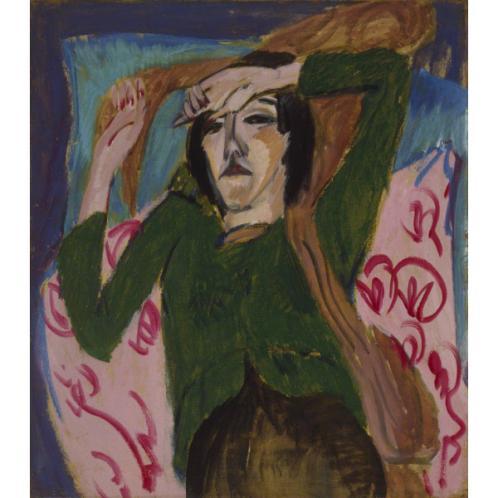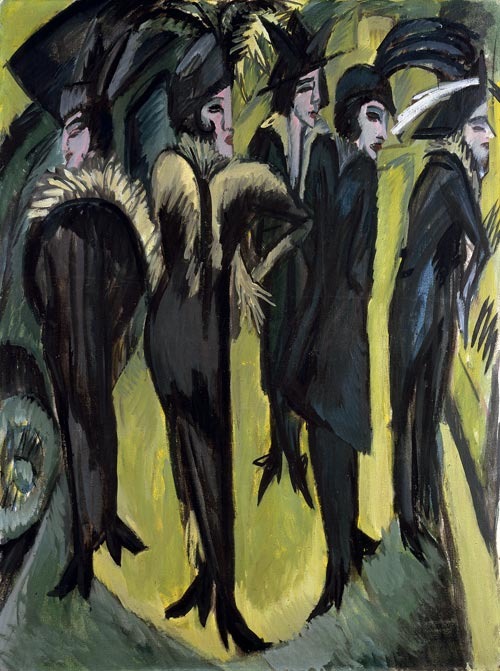Ernst Ludwig Kirchner: "Woman in a Green Blouse"

Ernst Ludwig Kirchner, "Woman in a Green Blouse," 1913. Oil on canvas, 31 5/8 x 27 5/8 in. Saint Louis Art Museum, Saint Louis, 903:1983.
Woman in a Green Blouse (Figure 1), a painting by German Expressionist Ernst Ludwig Kirchner, exemplifies the potency of the emotions conveyed through Expressionist portraiture. 1913, the year it was painted, was an ominous year for Europe, and for Germany in particular. The growing intensity of nationalism across the continent incited political tensions between countries, and the rapid expansion of modern industrialization led to a competitive race for military technologies. Germany would play a central role in the upcoming Great War, and the palpable apprehension and anxiety of the people engendered an atmosphere that artists were keen to communicate. Experts in German Expressionism Jill Lloyd and Magdalena Moeller contend, “Kirchner viewed the war with a sense of tragic foreboding and fear from the outset.” [i] The artist encapsulates this pre-war conflict through his use of emotion evident in both a poignant composition and an Expressionist technique.
The woman depicted is lying in a position that suggests despair and hopelessness: the back of her hand rests on her forehead and her eyes are slightly closed, indicating weariness and melancholy. Though the figure looks directly at the viewer, she is merely a stranger; the vagueness of the painting’s title implies a sense of anonymity, since Woman with a Green Blouse may describe any number of women. Kirchner is therefore using this woman as a microcosm for a larger body of emotions, in order to encapsulate his feelings toward his role as an artist in a society on the brink of war.
Kirchner made his presence as an artist in pre-war Germany known through his charismatic approach to modern art. Although trained as an architect, in 1905 he and three of his peers committed themselves to the study of art with their founding of The Bridge in Dresden. The artists’ group was devoted to the progression of modern art, in a way that diverged from traditional academic style toward a freer mode of expression, and their charisma helped bring about the movement of Expressionism. Woman in a Green Blouse is emblematic of Expressionism in its attention to movement through emphatic brushwork instead of accuracy in realistic composition. Short, directional brushstrokes imply tension while the woman’s gesture suggests motion more than stillness. Kirchner strays from the soft, demure beauty of the classical female portrait with the sharp angles in the composition and the woman’s bony features.

Ernst Ludwig Kirchner, "Five Women on the Street," 1913. Oil on canvas, 47 x 35 in. Museum Ludwig, Cologne.
The depiction of the face in the painting is indicative of how Expressionists were influenced by non-Western cultures; the mask-like simplification of the woman’s features alludes to primitivism, a concept also prevalent in some of Kirchner’s other paintings. Five Women on the Street (Figure 2), created in the same year as Woman in a Green Blouse, pictures women with similarly constructed faces to the one in the portrait in the way their abstracted qualities resemble African or Oceanic masks. Like Woman with a Green Blouse, Five Women on the Street is composed of sharp angles, and this tension generates an air of uncertainty. The air of mystery is augmented by the nondescript quality of the women; because they are all dressed alike, there is no sense of individuality that would give the viewer insight into their characters. Similarly, in Woman with a Green Blouse the figure’s simple, neutral-colored attire does not distinguish her from other women, and her namelessness allows the viewer to focus less on the character and more on the painting’s emotional intent. In both paintings, Kirchner emphasizes the women’s anonymity with imprecise titles, since they both could apply to a plethora of paintings. The color green is important in highlighting the figures in both works. However, in one, green separates the woman from the background through bold contrast, while in the other the women are bathed in a green light that amplifies the piece’s mystique.
In addition to the political tension in Germany in 1913, the year was significant for Kirchner because it marked the dissolution of The Bridge. Although the group had begun to encounter issues by this time, Kirchner’s writing of The Bridge Chronicle finally triggered the termination of the artists’ society. The artist’s account of The Bridge’s struggles and successes angered other members, who felt they were not adequately acknowledged for their contributions.[ii] Kirchner felt betrayed by his peers, and his dismay may have contributed to the distraught tone conveyed in Woman with a Green Blouse. The ending of The Bridge marked a turning point in Kirchner’s career, as he began to establish a reputation as an individual artist. Through solo exhibitions in Europe and his debut in the United States, Kirchner quickly gained recognition as an innovative modern artist.
Despite large setbacks, Kirchner continued his exploration of Expressionist art until his death in 1938. Like many of his contemporaries, including Max Beckmann, Kirchner was a victim to the Nazi Degenerate Art movement, and hundreds of his pieces were removed from museums in the 1930s. He was soon dismissed from Berlin’s Academy of Arts, further aggravating his frustration with German policies. Lloyd and Moeller describe this as a “period of utter pessimism for Kirchner, brought about by poverty and a lack of genuine success in Berlin.”[iii] Woman in a Green Blouse is just one example of how the artist utilized painting to channel his discontent with the swiftly changing situation in Germany. Kirchner admits in a letter written in 1917 “it seems as though the goal of my work has always been to dissolve myself completely into the sensations of the surroundings in order to then integrate this into a coherent painterly form,” explicating the purpose behind his pursuit of Expressionism.[iv] Woman in a Green Blouse is an illustration of this concept in the way it demonstrates the artist’s ability to effectively convey these “sensations” through painting, by highlighting the anonymity of individuals engendered by heightened political and social tension in 1913 Germany. Kirchner’s legacy as a leader in such a significant movement speaks to his influence in the development of modern art.
[i] Jill Lloyd and Magdalena Moeller, Ernst Ludwig Kirchner: The Dresden and Berlin Years (London: Royal Academy Books, 2003), 11.
[ii] Christian Weikop, “Ernst Ludwig Kirchner as His Own Critic: The Artist’s Statements as Stratagems of Self-Promotion,” Forum for Modern Language Studies 48, no. 4 (2012): 409.
[iii] Lloyd and Moeller, Kirchner, 12.
[iv] Deborah Wye, Kirchner and the Berlin Street (New York: The Museum of Modern Art, 2008), 101.